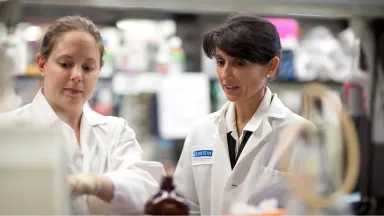
Hannes E. Buelow, Ph.D.
- Professor, Department of Genetics
- Professor, Dominick P. Purpura Department of Neuroscience
Area of research
- Neural patterning with a focus on extracellular matrices using the nematode Caenorhabditis elegans; Glycosaminoglycans in development as well as health and disease.
Phone
Location
- Albert Einstein College of Medicine Jack and Pearl Resnick Campus 1300 Morris Park Avenue Ullmann Building 709 Bronx, NY 10461
Research Profiles
Professional Interests
We utilize the small nematode Caenorhabditis elegans as a genetic model for much of our work. This organism has similar genes in type and number as mammals, including humans, and has been instrumental in discovering many cellular mechanisms that control animal (including human) development and diseases. In addition, the nervous system of C. elegans is understood better than any other nervous system, providing a unique opportunity to study basic aspects of neuronal development and function. We have three major projects in the lab.
Project I: Understanding dendrite patterning
Neurons or nerve cells are the basic building blocks of the nervous system. They contain structures that receive information from the environment or other neurons. These receiving structures are termed dendrites and are often elaborately branched processes that can resemble trees. On the other hand, the parts of neurons that transmit information to other neurons are processes called axons. Through the synaptic connections between an axon with the dendrites of another neuron(s) a neural network can be formed. Such networks in the brain are crucial for all aspects of animal behavior.
In many neurological conditions, such as autism spectrum disorders, schizophrenia and syndromes of intellectual disability the formation of dendrites is impaired or defective with sometimes less and disorganized dendrite structures and sometimes excessively branched dendrites. In one project, we seek to understand the basic biologic mechanisms that control dendrite patterning, because we believe that we need to understand these mechanisms first before we can start developing therapeutic approaches.
Project II: Understanding Neuronal rewiring during learning and memory
In a second project, we are investigating development and function of the connectome, i.e. the hardwiring of the nervous system. The neurons in an animal form a neural network by using for communication between nerve cells chemical connections (aka synapses) and electrical connections (aka GAP junctions). The nematode C. elegans remains the only animal for which we have the complete qualitative and quantitative connectivity of the nervous systems for both sexes of the animal. We are interested in how an animal's experience (e.g. during learning) can influence and change synaptic connectivity, i.e. the neural networks. To this end, we have developed methods to visualize cell-specific synaptic connections in live animals. We are now using a combination of genetic, behavioral, and imaging approaches to test how specific synaptic connections change in response to the environment and experience, and which genes mediate these processes.
Project III: Understanding and harnessing the molecular diversity of glycosaminoglycans.
In a third project, we are studying the role of proteoglycans, e.g. heparan sulfate (HS) proteoglycans in development an disease. We are asking how specific modification patterns of the polysaccharide HS determine the path of developing axons. For instance, we have shown that distinct modification patterns in HS serve specific and instructive functions during neural development leading us to formulate the ‘HS code’ hypothesis. We propose that defined combinations of modifications in the sugars of HS contain information and generate a molecular map that shapes animal development. In a multidisciplinary collaborative approach with the laboratories of Drs Almo, Steidl and Zheng, we are leveraging the molecular diversity of the HS code to define cells in mammals including mice and human in novel ways in both healthy and diseased states.
Selected Publications
Attreed M., Desbois M., van Kuppevelt T.H., and Bülow H.E. (2012) Direct visualization of specifically modified extracellular glycans in living animals. Nat. Methods, 9(5):477-479, published online April 1, 2012 as doi:10.1038/nmeth.1945.
Salzberg Y., Diaz-Balzac C.A., Ramirez-Suarez N.J., Attreed M., Tecle E., Desbois M., Kaprielian Z., and Bülow H.E. (2013) Skin-derived cues control arborization of sensory dendrites in Caenorhabditis elegans. Cell, 155(2): 308–320, published online on October 10 as http://dx.doi.org/10.1016/j.cell.2013.08.058.
Díaz-Balzac C.A., Lázaro-Peña M.I., Ramos-Ortiz G.O., Bülow H.E. (2015) The Adhesion molecule KAL-1/anosmin-1 regulates Neurite Branching through a SAX-7/L1CAM–EGL-15/FGFR Receptor Complex. Cell Reports, 11:1–8, published online on May 21 as http://dx.doi.org/10.1016/j.celrep.2015.04.057.
Díaz-Balzac C.A., Rahman M., Lázaro-Peña M.I., Martin Hernandez L.A., Salzberg Y., Aguirre-Chen C., Kaprielian Z., and Bülow H.E. (2016) Muscle- and skin-derived cues jointly orchestrate patterning of somatosensory dendrites. Current Biology, 26:1-9, published online on July 21 as http://dx.doi.org/10.1016/j.cub.2016.07.008.
Ramirez-Suarez N.J., Belalcazar H.M., Salazar C.J., Beyaz B., Raja B., Nguyen K.C.Q., Celestrin K., Fredens J., Færgeman N.J., Hall D.H., and Bülow H.E. (2019) Axon-dependent patterning and maintenance of somatosensory dendritic arbors, Developmental Cell, 48:229-244, published online on January 17, 2019 as https://doi.org/10.1016/j.devcel.2018.12.015.
Tang L.TH.*, Díaz-Balzac C.A.*, Rahman M., Ramirez-Suarez N.J., Salzberg Y., Lázaro-Peña M.I., and Bülow H.E. (2019) TIAM-1/GEF can shape somatosensory dendrites independently of its GEF activity by regulating F-actin localization. eLife; 8:e38949 DOI: 10.7554/eLife.38949.
Tang L.T.*, Trivedi M.*, Freund J., Salazar C.J., Lee G.L., Ramirez-Suarez N.J., Rahman M., Wang Y., Grant, B.D., Bülow H.E. (2021) The CATP-8/P5A-type ATPase is required for multiple aspects of neuronal patterning, PLoS Genetics, Jul 1,17(7):e1009475, published online July 1, 2021 as https://doi.org/10.1371/journal.pgen.1009475.
Piszczatowski R.T. #, Schwenger E. #, Sundaravel S, Stein C.M., Liu Y., Stanley P., Verma A., Zheng D., Seidel R.D., Almo S.C., Townley R.A.*, Bülow H.E.*, Steidl U.* (2022) A glycan-based approach to cell characterization and isolation: hematopoiesis as a paradigm, J. Exp. Med., Nov 7; 219(11): e20212552, published online on September 6, 2022 as e20212552. # contributed equally, * corresponding authors. https://doi.org/10.1084/jem.20212552.
Tang L.T. *, Lee G.L. *, Cook S.C., Ho J., Potter C.W., and Bülow H.E. (2023) Anatomical restructuring of a lateralized neural circuit during associative learning by asymmetric insulin signaling, Current Biology, 33:1–16, published online on August 16 as https://doi.org/10.1016/j.cub.2023.07.041.





